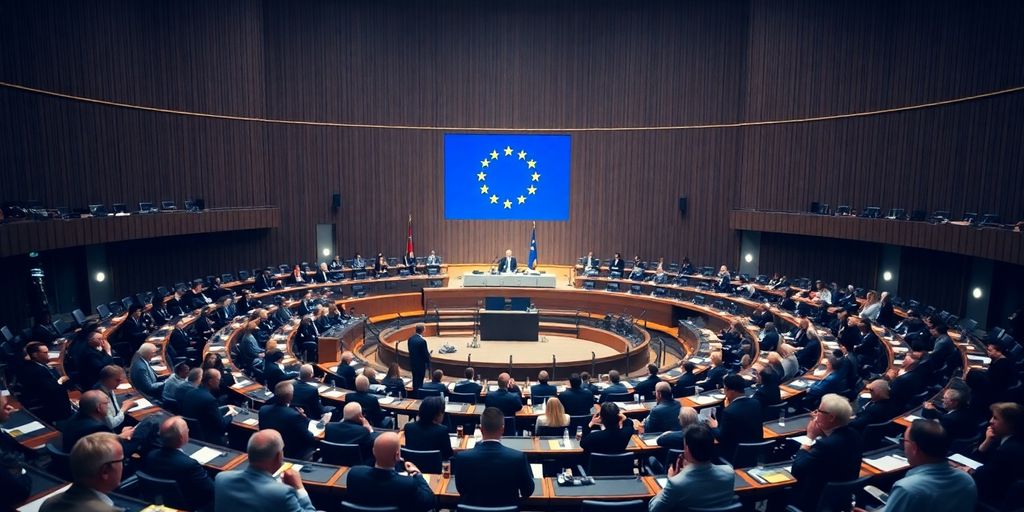The European Parliament has taken a significant step in regulating the cryptocurrency market by passing comprehensive rules known as the Markets in Crypto-Assets (MiCA) framework. This legislation aims to provide a clear structure for the crypto industry, ensuring consumer protection, environmental considerations, and financial integrity. As the first of its kind, the MiCA framework sets a global standard for crypto regulations, which could influence other regions, including the U.S.
Key Takeaways
- The MiCA framework introduces strict rules for crypto platforms, requiring them to inform users about risks.
- Stablecoins must maintain sufficient reserves and face transaction limits to ensure stability.
- The European Securities and Markets Authority (ESMA) gains new powers to protect investors and ensure market integrity.
- New regulations address environmental impacts, requiring firms to disclose energy consumption related to crypto operations.
- The legislation includes the ‘Travel Rule’ to enhance traceability of crypto transactions, aligning with global standards.
Understanding the EU’s New Crypto Regulations

Overview of MiCA Legislation
The Markets in Crypto-Assets (MiCA) regulation is a significant step towards establishing a clear framework for crypto-assets in the European Union. This legislation aims to create uniform rules for issuers of crypto-assets that have not been regulated before. By doing so, it seeks to enhance consumer protection and ensure market integrity across the EU.
Key Objectives of the Regulation
The main goals of MiCA include:
- Consumer Protection: Ensuring that consumers are well-informed about the risks associated with crypto-assets.
- Market Integrity: Preventing fraud and promoting a stable market environment.
- Environmental Responsibility: Addressing the environmental impact of crypto operations by requiring firms to disclose their energy consumption.
Impact on the Crypto Industry
The introduction of MiCA is expected to have a profound impact on the crypto industry. It will:
- Standardize regulations across all EU member states, making it easier for companies to operate.
- Require stablecoins to maintain sufficient reserves to meet redemption requests, ensuring stability in the market.
- Empower the European Securities and Markets Authority (ESMA) to oversee compliance and protect investors effectively.
The MiCA regulation is a game changer for the crypto landscape in Europe, providing clarity and consistency that the industry has long needed.
The Role of the European Securities and Markets Authority (ESMA)
ESMA’s New Powers and Responsibilities
The European Securities and Markets Authority (ESMA) is set to play a crucial role in the new crypto regulations. ESMA will have the authority to intervene and impose restrictions on crypto platforms that fail to protect investors adequately or jeopardize market integrity. This means that companies must adhere to strict guidelines to ensure they are operating within the law and safeguarding their users.
Investor Protection Measures
One of the primary goals of ESMA is to enhance investor protection. This includes:
- Ensuring transparency in crypto transactions.
- Mandating that platforms inform consumers about the risks involved.
- Establishing a public register for non-compliant crypto service providers.
Market Integrity and Financial Stability
ESMA’s oversight will also focus on maintaining market integrity and financial stability. By regulating public offers of crypto-assets, ESMA aims to prevent fraud and protect consumers from deceptive practices. This is particularly important in light of past incidents where investors were misled by fraudulent schemes.
The establishment of ESMA’s powers marks a significant step towards a safer and more regulated crypto environment in the EU.
In summary, ESMA’s involvement is essential for fostering a secure and trustworthy crypto market, ensuring that both investors and the broader financial system are protected from potential risks.
Stablecoins Under the New Regulations

Requirements for Stablecoin Reserves
Under the new regulations, stablecoins must maintain ample reserves to ensure they can meet redemption requests during mass withdrawals. This means that issuers need to have liquid and stable assets backing their stablecoins. The goal is to protect consumers and maintain trust in these digital currencies.
Transaction Limits for Large Stablecoins
To prevent market disruption, stablecoins that grow too large will face transaction limits. Specifically, transactions will be capped at 200 million euros (approximately $220 million) per day. This measure aims to enhance market stability and reduce risks associated with large-scale transactions.
Impact on Tether and USDC
The new rules will significantly affect major stablecoins like Tether and Circle’s USDC. These platforms will need to adapt their operations to comply with the regulations, ensuring they meet the new requirements for reserves and transaction limits. As a result, we can expect changes in how these stablecoins operate in the market.
The introduction of these regulations marks a pivotal moment for stablecoins, aiming to enhance consumer protection and market integrity.
In summary, the new regulations on stablecoins are designed to create a safer environment for users while promoting transparency and stability in the crypto market. We believe that these changes will lead to a more robust framework for stablecoins, ultimately benefiting the entire industry.
Environmental Considerations in Crypto Regulations

Disclosure of Energy Consumption
As we navigate the new regulatory landscape, one of the key requirements is the disclosure of energy consumption by crypto firms. This means that companies will need to report how much energy they use in their operations. This transparency is crucial for understanding the environmental impact of digital assets.
Environmental Impact of Digital Assets
The regulations also focus on the environmental impact of cryptocurrencies. We must consider how mining and transactions affect our planet. Here are some points to keep in mind:
- Carbon Footprint: The energy sources used for mining can significantly contribute to carbon emissions.
- Resource Depletion: Mining requires substantial hardware, which can lead to resource depletion.
- E-Waste: The rapid turnover of mining equipment generates a lot of electronic waste.
Regulatory Measures for Sustainability
To promote sustainability, the EU is implementing measures that encourage crypto companies to adopt greener practices. This includes:
- Incentives for Renewable Energy: Companies using renewable energy sources may receive benefits.
- Sustainability Reporting: Firms will be required to report on their sustainability efforts.
- Compliance with EU Standards: Companies must align with EU standards for environmental protection.
The new regulations aim to ensure that the crypto industry contributes positively to our environment while maintaining its innovative spirit.
In summary, as we embrace these regulations, we recognize the importance of balancing innovation with corporate sustainability reporting. By holding companies accountable for their environmental impact, we can work towards a more sustainable future in the crypto space.
Consumer Protection and Transparency
Informing Consumers About Risks
In the evolving landscape of crypto-assets, consumers must be well-informed about the potential risks involved. The new regulations aim to ensure that all relevant information is clearly communicated. Here are some key points:
- Clear disclosure of risks associated with crypto investments.
- Transparency regarding fees and charges.
- Information on the volatility of crypto-assets.
Transparency in Token Sales
The MiCA regulations introduce strict guidelines for token sales, enhancing transparency. This includes:
- Detailed information on the purpose and use of the tokens.
- Clear identification of the parties involved in the sale.
- Regular updates on the status of the project.
Liability of Crypto Platforms
With the new rules, crypto platforms will have increased responsibilities. They must:
- Ensure compliance with consumer protection laws.
- Provide accurate information to users.
- Be accountable for any misleading practices.
The MiCA legislation represents a significant step towards enhanced consumer protection in the crypto market, fostering trust and stability.
By implementing these measures, we believe that the EU is setting a strong precedent for consumer rights in the crypto space, ultimately benefiting all stakeholders involved.
The Crypto Travel Rule: Enhancing Traceability
Understanding the Travel Rule
The Crypto Travel Rule is a significant step towards improving the traceability of crypto transactions. It requires that information about the sender and receiver of crypto assets must accompany the transaction. This means that all crypto-asset service providers (CASPs) will need to share relevant details for every transfer, ensuring that transactions are not only secure but also transparent.
Implications for Crypto Transfers
- Mandatory Information Sharing: CASPs must share sender and beneficiary information for all transactions, with no minimum threshold.
- Enhanced Security: This regulation aims to prevent fraud and money laundering by making it harder for criminals to exploit the system.
- Global Standards: The EU’s approach sets a precedent that could influence regulations in other regions, promoting a more unified global standard for crypto transactions.
Comparison with Global Standards
The EU’s Travel Rule goes beyond the recommendations of the Financial Action Task Force (FATF), which only requires information sharing for transfers over €1,000. By implementing stricter rules, the EU is taking a proactive stance in the fight against financial crime.
The introduction of the Travel Rule is a crucial move to enhance the integrity of the crypto market and protect consumers from potential risks.
In conclusion, the Crypto Travel Rule is a vital component of the EU’s regulatory framework, aiming to create a safer and more transparent environment for crypto transactions. As we move forward, it will be interesting to see how this regulation shapes the future of the crypto industry and influences global standards.
Anti-Money Laundering (AML) Measures
AML Obligations for Crypto Providers
As we navigate the new landscape of crypto regulations, it is crucial to understand the AML obligations that crypto-asset service providers (CASPs) must adhere to. These obligations are designed to enhance the fight against money laundering and terrorist financing in the EU. Here are some key points:
- All CASPs must comply with the Travel Rule, which requires sharing information about the sender and recipient for all crypto transfers.
- Transactions exceeding €1,000 from self-hosted wallets must also be reported.
- CASPs are expected to implement robust systems to ensure compliance with these regulations.
Role of the Financial Action Task Force
The Financial Action Task Force (FATF) plays a significant role in shaping AML measures globally. The EU’s regulations align with FATF recommendations, making it more difficult for criminals to misuse cryptocurrencies for illicit activities. This alignment is essential for maintaining the integrity of the financial system.
Preventing Illicit Crypto Flows
To effectively combat money laundering, we must focus on preventing illicit crypto flows. This involves:
- Implementing strict KYC (Know Your Customer) protocols to verify the identities of users.
- Monitoring transactions for suspicious activity and reporting it to authorities.
- Enhancing cooperation between CASPs and law enforcement agencies to share information and best practices.
The EU’s rules on anti-money laundering and countering terrorist financing protect its financial system and contribute to security and growth.
By adhering to these measures, we can help create a safer and more transparent crypto environment for everyone.
Comparing EU and US Crypto Regulations
EU’s Regulatory Approach vs. US
In the European Union, the new MiCA legislation sets a clear framework for crypto regulations, which is seen as a significant step forward. In contrast, the United States has a more fragmented approach, with different states implementing their own rules. This can create confusion and inconsistency for crypto businesses operating across state lines.
Potential for Global Influence
The EU’s comprehensive regulations may serve as a model for other regions, potentially influencing global standards. EU banking regulations have provided a competitive advantage for crypto firms compared to the challenges faced by their U.S. counterparts. This could lead to a shift in how countries approach crypto regulation, as they look to the EU for guidance.
Challenges in Harmonizing Regulations
Despite the EU’s efforts, there are still challenges in harmonizing regulations across its member states. Each country has its own unique market conditions and regulatory environments, which can complicate the implementation of a unified approach. Similarly, the U.S. faces challenges in creating a cohesive regulatory framework due to its decentralized system.
The differences in regulatory approaches between the EU and the U.S. highlight the need for a more coordinated global strategy to address the complexities of the crypto market.
In summary, while the EU is taking significant steps towards comprehensive crypto regulations, the U.S. continues to grapple with a patchwork of state-level rules. As the landscape evolves, it will be crucial for both regions to find common ground to foster innovation while ensuring consumer protection and market integrity.
The Future of Crypto Regulations in the EU
Timeline for Implementation
As we look ahead, the implementation of the new regulations is expected to begin next year. This timeline is crucial for crypto companies as they prepare to adapt to the new rules. The Markets in Crypto-Assets (MiCA) legislation will create a unified framework across the EU, allowing businesses to operate more smoothly without navigating through different national regulations.
Expected Challenges and Opportunities
While the new regulations present significant opportunities for growth and innovation, they also come with challenges. Here are some key points to consider:
- Compliance Costs: Companies may face increased costs to meet the new regulatory requirements.
- Market Adaptation: Businesses will need to adjust their operations to align with the new rules, which may take time.
- Consumer Trust: Enhanced regulations can lead to greater consumer confidence in the crypto market.
Long-term Impact on the Crypto Market
The long-term effects of these regulations could reshape the crypto landscape in Europe. We anticipate:
- Increased Investment: A more stable regulatory environment may attract more investors.
- Innovation Boost: Clear guidelines can foster innovation within the industry.
- Global Influence: The EU’s approach may set a precedent for other regions, encouraging them to adopt similar regulations.
The EU’s new rules on markets in crypto-assets aim to better protect consumers and investors, regulate risks against financial crime, and boost innovation.
In conclusion, as we move forward, the future of crypto regulations in the EU looks promising yet complex. The balance between fostering innovation and ensuring consumer protection will be key to the success of these regulations.
Industry Reactions to the New Regulations

Feedback from Crypto Companies
As the EU Parliament passed the MiCA regulations, we observed a mix of reactions from various crypto companies. Many industry leaders expressed relief and optimism, viewing this as a significant step forward for regulatory clarity. For instance, Andrew Whitworth from Ripple stated that this legislation would provide the operational clarity needed to foster innovation across Europe.
Concerns and Criticisms
However, not all feedback was positive. Some companies raised concerns about the potential for overregulation, which could stifle growth and innovation. Key points of concern include:
- Increased Compliance Costs: Smaller firms may struggle to meet the new requirements.
- Risk of Fragmentation: There are fears that inconsistent implementation across member states could lead to a fragmented market.
- Impact on Privacy: The Travel Rule, which mandates tracking of transactions, has raised alarms among privacy advocates.
Support from Industry Leaders
Despite the criticisms, many industry leaders have shown support for the new regulations. They believe that a unified regulatory framework will help protect consumers and enhance market integrity. Notable supporters include:
- Mairead McGuinness, who emphasized the importance of these regulations for consumer protection.
- Patrick Hansen from Circle, who called MiCA a "true game changer" for the EU crypto landscape.
- Changpeng Zhao, CEO of Binance, who described the regulations as a pragmatic solution to industry challenges.
The MiCA regulations represent a pivotal moment for the crypto industry, balancing innovation with necessary oversight.
In conclusion, while the MiCA regulations have sparked a variety of reactions, they are seen as a crucial step towards a more regulated and stable crypto market in the EU. We believe that the long-term benefits will outweigh the initial challenges as the industry adapts to these new rules.
Conclusion
The recent vote by the EU Parliament marks a significant step forward in the regulation of cryptocurrencies. With the new rules, platforms must now inform users about the risks involved in crypto transactions. Additionally, stablecoins like Tether and USDC will need to keep enough reserves to handle large withdrawals. The European Securities and Markets Authority (ESMA) will have the authority to restrict or ban platforms that fail to protect investors or disrupt market stability. Moreover, companies will have to disclose their energy use and its environmental impact. This legislation is expected to take effect next year, paving the way for a safer and more transparent crypto market in Europe. As Andrew Whitworth from Ripple noted, consistent rules across the EU will help foster innovation while protecting consumers. Overall, these regulations could set a global standard for how cryptocurrencies are managed and monitored.
Frequently Asked Questions
What are the new rules for crypto in the EU?
The EU has created new rules to regulate cryptocurrencies, making sure companies are clear about risks and how they operate.
How will stablecoins be affected by these regulations?
Stablecoins like Tether and USDC must keep enough money in reserve to handle large withdrawals and may face limits on daily transactions.
What is the role of the European Securities and Markets Authority (ESMA)?
ESMA will monitor crypto platforms and can step in to ban or limit them if they don’t protect investors properly.
How will these regulations help the environment?
Companies will need to share how much energy they use and the environmental effects of their digital assets.
What does the ‘Travel Rule’ mean for crypto transactions?
The Travel Rule requires that information about the sender and receiver of crypto transfers must be shared, making transactions traceable.
What are the anti-money laundering measures for crypto?
Crypto companies must follow rules to prevent money laundering, ensuring they track and report suspicious activities.
How do EU regulations compare to those in the US?
The EU’s approach is more comprehensive, aiming for a unified set of rules, while the US has a more fragmented system.
What do industry leaders think about these regulations?
Many in the crypto industry see these rules as a positive step for clarity and safety, while some express concerns about their strictness.





